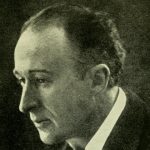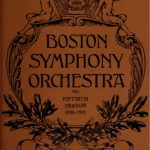
Symphony No. 2 ‘Romantic’ Op. 30
Howard Hanson
Composed: 1930
Length: ca. 28 minutes
Orchestration: piccolo, 2 flutes, 2 oboes, English horn, 2 clarinets, 2 bassoons, contra bassoon, 4 horns, 3 trumpets, 3 trombones, tuba, timpani, 3 percussion, harp, and strings
CONCERT NOTE FROM WORLD PREMIERE BY THE BOSTON SYMPHONY ORCHESTRA FOR THEIR 50th ANNIVERSARY SEASON 1930-31:
Adagio; Allegro moderato.
Andante con tenerezza.
Allegro con brio.
(Born at Wahoo, Neb., on October 28, 1896; now living at Rochester, N.Y.)
We are indebted to Dr. Hanson for the following notes:
Concerning my second symphony, as the subtitle implies, it; represents for me a definite and acknowledged embracing of the romantic phase. I recognize, of course, that romanticism is, at the; present time, the poor stepchild, without the social standing of her elder sister, neo-classicism. Nevertheless, I embrace her all the more fervently, believing, as I do, that romanticism will find in this country rich soil for a new, young, and vigorous growth.
My aim, in this symphony, has been to create a work young in spirit, romantic in temperament, and simple and direct in expression. The work is in three movements. The first, Adagio – moderato, begins with an atmospheric introduction in the woodwinds, joined first by the horns, then the strings, and finally the brass choir, and then subsiding.
The principal theme is announced, Allegro moderato, by four horns, with an accompaniment of strings; and woodwinds, and is imitated in turn by the trumpets, woodwind, and strings. An episodic theme appears quietly in the oboe and then in the solo horn. A transition leads into the subordinate theme, Lento, with the theme itself in the strings and a counter-subject in the solo horn.
The development section now follows with the principal theme announced in a changed mood by the English horn and developed through the orchestra. The episodic theme, influenced by the principal theme, also takes an important part in this section. The climax of the development section leads directly to the return of the principal theme in the original key by the trumpets. This is followed in turn by the episodic theme, now in the clarinets and then in the first horn, with canonic imitation in the oboe. The subordinate theme then follows, and the movement concludes quietly in a short coda.
The second movement, Andante con tenerezza, begins with its principal theme announced by the woodwinds with a sustained string accompaniment. An interlude in the brass, taken from the introduction of the first movement and interrupted by florid pas- sages in the woodwinds, develops into the subordinate theme, which is taken from the horn solo in the first movement. A transition, again interrupted by a florid woodwind passage, leads into a re-statement of the principal theme of the movement.
The third movement, Allegro con brio, begins with a vigorous accompaniment figure in strings and woodwinds, the principal theme of the movement — reminiscent of the first movement— entering in the four horns and later repeated in the basses. The subordinate theme, Molto meno mosso, is announced first by the violoncellos and then taken up by the English horn, the development of which leads into the middle section, Piu mosso. This section begins with a pizzicato accompaniment in the violas, violoncellos and basses over which is announced a horn call. This call is taken up by the trombones and leads into a fanfare first in the trumpets, then in the horns and woodwinds, and then again in the trumpets and woodwinds. The climax of this fanfare comes with the announcement of the principal theme of the first movement by the trumpets, against the fanfare rhythm in the woodwinds. The development of this theme leads into a final statement of the subordinate theme of the first movement fortissimo. A brief coda of this material leads to a final fanfare and the end of the symphony.
CONCERT NOTE FROM THE 1996 NEW YORK PHILHARMONIC PERFORMANCE:
He composed his ‘Romantic’ symphony in 1930 on commission from the Boston Symphony Orchestra in celebration of its fiftieth anniversary, and Serge Koussevitzky gave the first performance with that orchestra on November 28, 1930.
The work is dedicated to Rush Rhees. The score calls for two flutes and piccolo, two oboes and English horn, two clarinets, two bassoons, [contra bassoon], four French horns, three trumpets, three trombones, tuba, timpani, snare drum, cymbals, harp, and strings.
As one of the beneficiaries of Serge Koussevitzky’s enthusiastic devotion to the cause of American music, Howard Hanson had a long history with the Boston Symphony Orchestra. In 1929, still in his early thirties but already the head of an important conservatory and the recipient of three honorary doctorates, he conducted the orchestra in his Symphony No. 1, the ‘Nordic’ (which he had written six years before when he was the first winner of the American Prix de Rome in music). On that occasion Koussevitzky invited him to compose a work in honour of the Boston Symphony 0rchestra’s fiftieth anniversary coming up in 1931. The piece was in good company; among the other Boston Symphony Orchestra fiftieth anniversary commissions were Copland’s Symphonic Ode, Gershwin’s Second Rhapsody Hindemith’s Concert Music for Brass and Strings, Honegger’s Symphony No. 1, Roussel’s Symphony No. 3, and Stravinsky’s Symphony of Psalms.
Hanson’s warm relationship with Boston would continue: in 1939 he conducted the Bostonians in the first performance in a public concert of his Third Symphony (it had already been played on broadcasts by CBS and NBC) and, in 1943, he led the orchestra in the premiere of his Symphony No. 4, ‘Requiem’.
Appropriately enough, the touching Elegy in Memory of Serge Koussevitzky was also the fulfilment of a Boston commission, this one tendered by Charles Munch for the orchestra’s seventy-fifth anniversary.
Hanson’s parents, Hans and Hilma Hanson, were Swedish immigrants, and his ‘Nordic’ Symphony was a proud celebration of his ancestry. He learned piano from his mother, became an able cellist, and studied at the University of Nebraska, the Institute of Musical Art (now The Juilliard School), and Northwestern University.
While he was a senior at Northwestern, Frederick Stock and the Chicago Symphony performed his Symphonic Prelude. A lifetime of teaching began with an appointment to the faculty of the College of the Pacific at San Jose, California.
He spent three years at the American Academy in Rome; then, on a visit to Rochester; New York, he met and mightily impressed George Eastman of Kodak fame. Eastman was looking for a director for the music school that had just been founded with his money (and his name) as an adjunct to the University of Rochester; and so it came about that Hanson, not quite 28, became the first director of the Eastman School of Music. There he remained for 40 years, until 1964.
From the beginning Hanson’s career prospered: his music was widely performed, and even the Metropolitan Opera, in a rare moment of acknowledging American music, staged the premiere of The Merry Mount in 1934.
Hanson was a good colleague to his fellow-composers, organizing an important annual festival of American music at Eastman and, as an expert conductor; making valuable recordings of American works. His last act at Eastman was to found there an Institute of American Music.
Hanson was as much a conservative in life as in music, and it must be said that anti-Semitism and homophobia were sentiments not entirely foreign to him.
He was retired from Eastman by the late 1960s when things were heating up in American schools and universities; he had, however, begun an uninhibited weekly column for the Rochester Times-Union, and from that platform he not only addressed a wide range of musical issue with vigorous common sense, but also complained tirelessly about student protests against the Vietnam war, anarchy in public-school classrooms, and the beginnings of what we had not yet learned to call “p.c.” – all this, of course, the fault of “liberals”.
Along with Copland, Piston, and Sessions, Hanson was one of the strong personalities that emerged on the American scene in the 1920s. Reviewing a Boston Symphony Orchestra concert in the January-February 1940 issue of Modem Music, Elliott Carter wrote: “Among the reactionary pieces played by the Boston Orchestra, Howard Hanson’s Third Symphony proved once again how skilful, fine, and ambitious a composer he is.” Carter, himself nurtured on Ives, Schoenberg, Bartok, and Stravinsky meant “reactionary” as a disapproving adjective, and “ambitious” could be double-edged; on the other hand, “skilful” and “fine” are clear enough. One might also have cited Hanson’s 1960 book, Harmonic Materials of Modern Music, as evidence that he was more aware of contemporary techniques and possibilities than one might infer from his compositions.
Hanson is consistently at his best in works in which he speaks quietly and is content to be a musician and skilled craftsman, i.e., in which weight of utterance is not an issue: works like the Concerto for Organ, Harp, and Strings (1941), the ‘Requiem’ Symphony (1943), the Serenade for Flute, Harp, and Strings (written to celebrate his own wedding to Margaret Elizabeth Nelson in 1946), and the exquisite Elegy in Memory of Serge Koussevitzky (1956).
For more than seven decades now, the Romantic Symphony has been Hanson’s most loved composition.
Program Notes Locations:
Boston Symphony Orchestra Archive
http://worldcat.org/digitalarchive/content/server15982.contentdm.oclc.org/BSYMO/PROG/TRUSVolume5/Pub411_1930-1931_BSO_FriSat_Wk07.pdf
New York Philharmonic Archive
http://archives.nyphil.org/index.php/artifact/6da762d3-2144-4031-81c1-d6f4e53b9060/fullview#page/3/mode/1up

The Walk to the Paradise Garden
Frederick Delius
Composed: 1906
Length: 10 minutes
Orchestration: 2 flutes, oboe, English horn, 2 clarinets, 2 bassoons, 4 horns, 2 trumpets, 3 trombones, timpani, harp, and strings
Delius’s The Walk to the Paradise Garden comes from his opera ‘A Village Romeo and Juliet’ composed between 1900 and 1901. This purely orchestral interlude was added much later, in 1906, just before the opera’s premiere in Berlin in February 1907.
Delius had just turned 45 at the time, a rather late age to reach artistic maturity, but his musical style needed time to steep, expressing as it does a profound spirituality and an acceptance of life’s vagaries informed by the experience of nature.
Delius wrote his own libretto after others’ attempts had proved unsatisfactory, another indication of his resolute vision for the work. The source for the text was the Swiss realist Gottfried Keller’s novella ‘Romeo und Julia auf dem Dorfe’ (1876) a story about the love of two young peasants frustrated by a feud between their families.
Delius arranged the libretto into six scenes, each exploring a different spiritual state. The thread that runs through them all is his juxtaposition of the immutability of nature, which constantly renews itself, with the transitory condition of human experience. As the young lovers drift through life, and everything they encounter makes them suffer, they find one moment of happiness in nature – in the Paradise Garden – away from everyone else. At the end of the opera, they resolve to commit suicide together, drifting out onto a river in a hay barge, which they scuttle after a rapturous duet, a “love-death” in the manner of Tristan und Isolde.
The Walk to the Paradise Garden actually wasn’t part of Delius’ original conception of the opera; adding it only to accommodate a lengthy scene change between a fairground and a mountain inn. The result is one of Delius’ most impressive orchestral works, a tone poem that draws together motives from the previous five scenes.
The piece begins with the second horn (doubled by bassoon) introducing a warm, unhurried theme that is then taken up by the English horn and reworked and fragmented among the other winds. For much of the interlude’s course, the winds play an almost soloistic role, recalling the atmosphere of “Forest Murmurs” from Wagner’s opera Siegfried. The interlude reaches a climax with a full orchestral crescendo followed by a rapturous statement of the opera’s “love” theme in radiant B major, as the young couple finds peace, however fleetingly, in nature. The music ends, trailing off into silence, as they return to life and to the events that will eventually bring about their union in death.
– John Mangum

The Pool and the Star
Lisa Cheney
Composed: This version 2016
Length: 9 minutes
Orchestration: piccolo, 2 flutes, 2 oboes, English horn, 2 clarinets, bass clarinet, 2 bassoons, 4 horns, 3 trumpets, 3 trombones, tuba, timpani, 2 percussion, harp, piano and strings
The Pool and the Star is inspired by a poem of the same name by the late Australian poet, Judith Wright. The composer writes, “I have often found Wright’s work a stimulus for creative expression, and on this occasion it was the vivid imagery and evocative language in ‘The Pool and the Star’ that invited my musical response.”
The work loosely captures the narrative of the poem in which the pool, in love, each night awaits patiently for the rising of a star to bring to life the time and waters from which the pool gathers itself together. Venturing through and between two worlds, the music depicts earth and water on one hand, and on the other, sky and space. Accordingly, the piece is through-composed commencing with a portrayal of calm and tranquility and progressing through a series of changes of varying intensity, returning in the closing bars to music akin to the opening.

